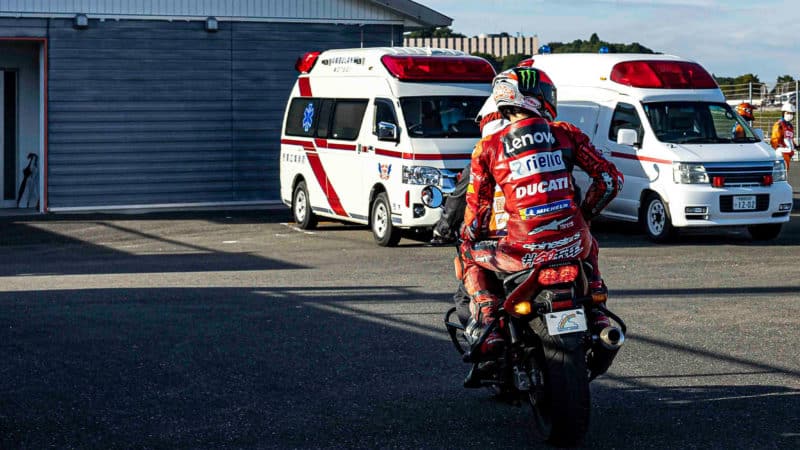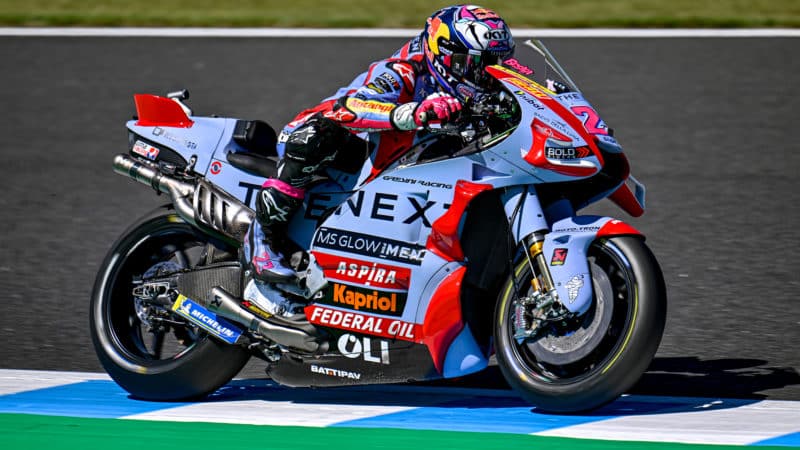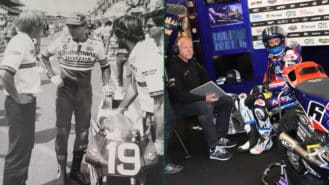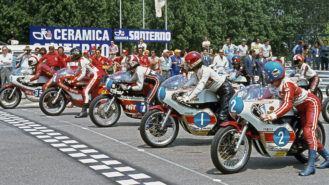While Miller stormed away out front for his first victory in 18 months, attributing his growing pace at recent races to a major set-up shuffle at June’s Barcelona tests and “having more fun than I’ve ever had on a motorcycle”, Bagnaia struggled with MotoGP’s dreaded front-tyre temperature/pressure problems.
“My front pressure was very, very, very high, so I was struggling to stop the bike,” he said. “This was one of the first times this year I was in a big group, so we weren’t prepared for that.”
For once a Ducati was undone by the technology pioneered by the Bologna factory, which creates heat waves behind the bikes, plus vacuums which make braking in their wake very tricky and create more wheelies for the same reason.
Neither could Bagnaia use the Desmosedici’s awesome power out of Motegi’s many slow turns, which lead onto long straights, making Honda’s home circuit the best track of them all for the Ducati.
While Miller’s bike rocketed out of the corners – the Aussie and others were engaging their shapeshifters five times each lap, more than anywhere else – Bagnaia’s bike didn’t.
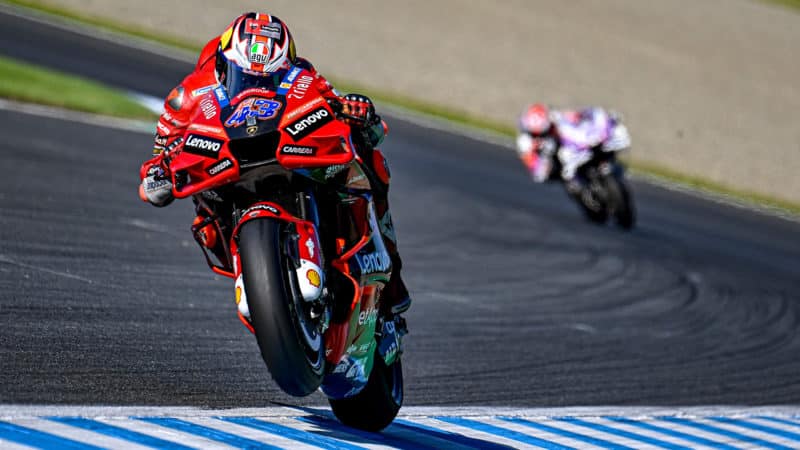
Miller was glorious to watch, dancing around Motegi on his GP22
Ducati
“I wasn’t able to put the power to the ground for a mix of things: spinning sliding and wheelies,” he said. “I prefer not to have so many electronics controls. I prefer to control the bike with the gas and the rear brake, because there’s less filter.”
Once again Nanmadol did him in, because (like everyone else) he only had one dry session on Friday and a dry morning warm-up to work on mappings and settings.
“For sure I needed more time to be perfect,” he said.
With just five laps of the race to go he finally got past Bastianini and set his sights on Quartararo. Going into the last lap they were eighth and ninth, just metres apart, with Bastianini right there, ready to take advantage of any chaos and certainly not staying behind for the good of his fellow Ducati rider.
At Turn 3 Bagnaia lunged to Quartararo’s inside but he was too far back and would’ve collided with the Yamaha if he hadn’t grabbed some more brake to extricate himself from the situation, losing the front in the process. As he went down he missed Quartararo by centimetres, not metres.
When Bagnaia stood up in the gravel trap he started clapping, ironically congratulating himself for his third crash of the year: the first at Le Mans, while chasing – guess who? – winner Bastianini, the second at Sachsenring, while going after winner Quartararo, and the third at Barcelona, when he was taken out by Takaaki Nakagami.
What does this tell us about Bagnaia as a racer? He is mega-fast when he’s alone, doing his metronome thing, but he seems to get rattled in a battle, a bit like Jorge Lorenzo and Dani Pedrosa sometimes did.
And was his risky attack on Quartararo really worth it for just one extra championship point? (MotoGP awards seven points for ninth, eight for eighth).
“One point can make a difference, so I was trying to do it,” he explained. “I was too ambitious – finishing behind Fabio or waiting for a safer opportunity to overtake would’ve been better, but I’m trying to win the championship.
“The only luck we had today is that I didn’t touch Fabio when I crashed. The race was a big mess for me and I’m not happy about it.”
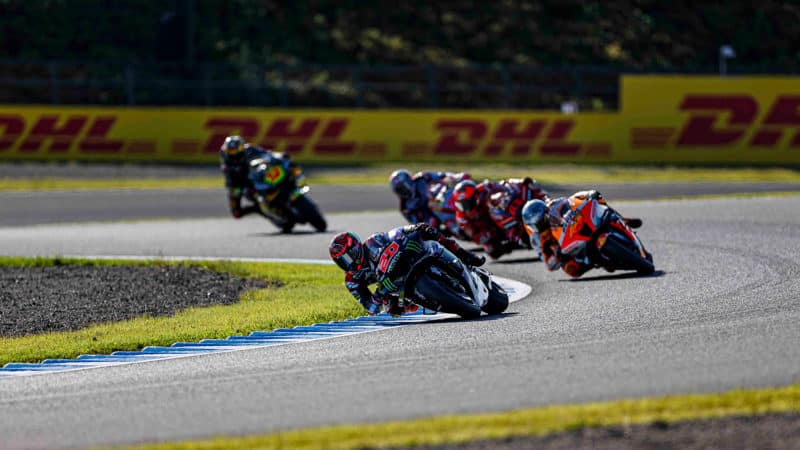
Quartararo battled for eighth with Pol Espargaró, Bagnaia and Bastianini. It would’ve been a bad result if his two main title rivals hadn’t failed to score
Yamaha
Quartararo heard Bagnaia’s Desmosedici clattering across the Motegi asphalt, but it wasn’t until he returned to his garage that his team gave him the maths: his title lead had increased from ten points with six races to go to 19 with five races to go.
When the paddock left Aragon it seemed like he was a dead man walking. Now he may just hold on for his second consecutive title.
The reigning world champion wasn’t only lucky that his closest championship rival got too greedy. He was even luckier that his other big title threat had a disastrous Sunday that made Bagnaia’s Saturday woes pale into insignificance.
Aleix Espargaró qualified on the second row and knew this was his best chance to take a load of points off both riders just ahead of him in the championship.
The 33-year-old Italian had ended the only dry practice session just seven-hundredths behind Miller because Aprilia’s 2022 RS-GP was a completely different motorcycle to the machine that contested the last Japanese GP in 2019.
While all MotoGP bikes have changed significantly since then – downforce aerodynamics, shapeshifters and so on – the Aprilia was the only completely new motorcycle at Motegi. And the lap times told the story – while other riders improved around a second from FP1 in 2019 to 2022, Espargaró was two seconds faster.
Last time Espargaró contested the Japanese GP he rode the RS-GP with its troublesome 75-degree V4 engine, which vibrated so badly that it caused chatter and was so peaky that engineers had to gear it so low that it made the bike super-nervous to ride. Already on Friday the RS-GP was using some gear ratios 12mph taller than in 2019, just because the 90-degree engine makes so much more power and torque.
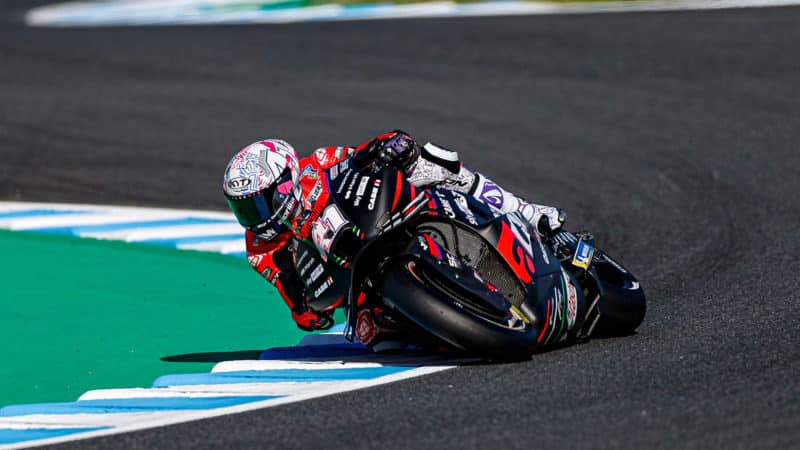
Espargaró had a grim ride from last to 16th and no points, through no fault of his own
Aprilia
“It’s unbelievable how much the bike has changed,” said Espargaró. “If I could show you the geometry data you’d see that the 2019 bike here was like a motocross bike, super high! Now the bike is longer, with much better power and torque. Also, this track was so bad for wheelies for us, now we don’t even half have that problem, even with much more power.”
Thus the Aprilia garage was all sweetness and light at Motegi, until the riders were waved off for the warm-up lap. Motegi is very heavy on fuel consumption, so riders need to eke their way through the sighting lap.
“We have an eco-map that doesn’t let us do more than 100 kays [62mph] or 5000rpm during the warm-up lap,” said Espargaró later, still distraught because his greatest chance of putting himself into the thick of the title fight had been ruined by the simple click of a laptop mouse, or rather the lack of the click that should’ve disengaged the eco map for the warm-up lap.
“I changed bikes in the pits but the second bike had the soft rear tyre and I can’t ride with that tyre, the bike was pushing the front everywhere. I was also nervous and making a lot of mistakes.
